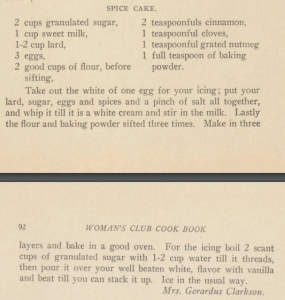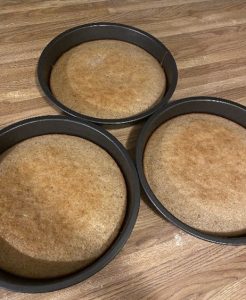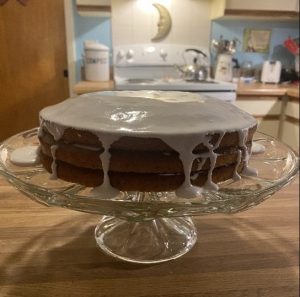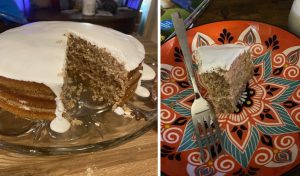This post was guest authored by Rebekah Nault, Library Specialist in Library Services at the Tampa Library
From an early age, I tried to establish a solid relationship with baking, even though there were times when baking thought we would be better as acquaintances. My high school baking attempts were more misses than hits, with the highlight being me ugly crying over a pile of simultaneously under-cooked and burnt chocolate “cake”. I had the passion for baking, but not the patience. It was not until I realized that baking is essentially chemistry that my cakes actually looked (and tasted) as they should.
THE COOKBOOK
As I delved into the archives, I came across the recipe for a spice cake from the Woman’s Club of Jacksonville Florida’s 1908 cookbook. 116 years ago, Mrs. Gerardus Clarkson (also known as Clara Rebecca Ferree Clarkson) submitted this spice cake recipe along with thirty others. Founded in 1897, the Woman’s Club of Jacksonville (WCJ) had two hundred seventy members by 1912 (Meyer, 1994, p. 18). The WCJ worked tirelessly on various passions with the overarching goal of improving the quality of life in Florida. Meyers describes the variety of projects during the Florida Federated Woman’s Club meeting in Jacksonville in 1899:
Beautification of towns, formation of forestry clubs, tree planting, discussions of current topics, organizations for children and clubs for young girls, support of public libraries, studies in various literary and historical subjects, philanthropic work that furnished nurses, medicine, and food for the poor. (p. 46).
Women used clubs to positively impact lives and improve living conditions via organization and direct action before they had access to the established (and male focused) political process. Meyer describes one of the greatest obstacles that women faced when doing their club work was often from their own husbands (p. 47). Mrs. Cummer, the WCJ’s fourth president (1902-1904), praised her own supportive ‘club husband’ but noted that club women were often told “A woman’s place is in the home” and that she was “reviled to her face for having anything to do with such an iniquitous movement” (p. 47). Mrs. Cummer, along with the other club women, were not deterred and were, perhaps, a little bit inspired. Upon being scolded by men that they should be at home, Meyer quotes the FFWC historian, Mrs. Blackman as saying:
Thanks be, there were enough women with spinal cords starched stiff, who raised their undaunted eyebrows and said, ‘Ah, indeed! To this masculine mandate – and went forth and did as they saw fit. (p. 47)
And how did the Woman’s Club of Jacksonville see fit to move forward? By publishing a cookbook and using the proceeds to fund their beloved club.
THE RECIPE
Mrs. Clarkson’s Spice Cake Recipe:

First, I rewrote the recipe to familiarize myself with the process and to cross reference any questions or techniques before I was in the middle of baking. I knew from Figoni’s How Baking Works that cake flour is preferred to standard flour when making high liquid and sugar to flour ratio cakes because it produces a thicker batter resulting in a “lighter texture, higher volume, and a finer, softer crumb” (pg. 94). For this recipe, a “1-2 cup lard” is listed; whenever you see a dash between numbers in older recipes, it indicates a fraction, so for the spice cake ½ cup of lard is required.
THE BAKE
After rewriting the recipe, I gathered my ingredients. The grocery store was out of ground cloves and nutmeg but did have them in their full forms. I thought it added a level of authenticity to have to grate and process the spices myself. I assumed it would be easy to crush the cloves with my mortar and pestle, but it was not. After several minutes of smashing, I must confess I ended up throwing the cloves into my coffee bean grinder to properly pulverize them.

Grating the nutmeg was significantly easier, and quite satisfying. Each spice filled my kitchen with the smells of fall. After I gathered, measured, and weighed each of the ingredients, it was time to mix. I made sure to reserve just the white of one egg for the icing, and then whipped the rest of the eggs, sugar, lard, spices, and a pinch of salt until they were thoroughly creamed. When I added the cold milk, it caused the lard to mildly clump (which nearly caused panic- until, thankfully, it all creamed together again).
Sifting the flour and baking powder was fun because I got to use my old-fashioned flour sifter. I made sure to weigh out the cups of flour prior to sifting (as per the recipe), and then repeated the sifting process three times. Once the baking powder and flour were well mixed and aerated together, I slowly added them to the creamed sugar, lard, and spices. I poured the delicious smelling batter into three well buttered round cake pans. The recipe ordered for the cake layers to bake in a “good oven”. Research told me that a “good oven” is the same as a “moderate oven” and that the ideal temperature is around 325 degrees (McCormick 2021).
While the cakes baked, I stayed in the kitchen, cleaned up, and prepared to make the icing. In the past whenever I’ve baked a cake one of my big stumbling blocks was not allowing the cake to properly cool before icing it. Luckily, these cakes were thin and cooled quickly when I pulled them out of the oven. I made sure to periodically check and rotate the pans in the oven to make sure they were getting heated evenly. I knew they were done when the tops and edges began to brown and a toothpick inserted in the center came out clean. Rotating the pans worked quite well, and when I pulled them out, they made my house smell like my favorite time of year – autumn.

As the cakes cooled, I had to tackle the step I’d been low-key dreading – the icing. I took the egg white I’d set aside and thoroughly whipped it. On the stove, I put two scant cups of sugar with a half a cup of water and mixed as it began a slow boil. The recipe requires the sugar to thread, and a quick search revealed that sugar begins to thread at the relatively low temperature of 230 degrees. I set up my cooking thermometer and alternated whisking and checking the temperature. Right as the mixture began to boil it reached the proper temperature, and I immediately poured it over the egg white in my stand mixer.
Initially, the icing concerned me because it appeared to be much too viscous. However, as it mixed, and I added the vanilla extract, it began to thicken. The icing behaved and tasted similarly to marshmallow, but as it cooled, it hardened in a way that reminded me of the icing on cinnamon rolls.
The recipe is vague on how to apply the icing, so I took it upon myself to put a little between each layer and then to pour the rest on top. It did not make for the most aesthetic cake, but what it lacked in looks, it made up for in flavor. The sponge was moist, and a perfect blend of spices while not being too sweet. The icing on the top significantly raised the sweetness but did not overwhelm the palate.

My family loved the cake, even more than I anticipated. My husband and son both devoured a piece and reported that it was not too sweet at all. My son said it was well balanced with the spice and the sweet, and my husband enjoyed it so much that he snuck back into the kitchen and took a second serving.

Explore more historic recipes:
- USF Libraries Digital Collections’ Historic Cookbook Collection
- Woman’s Club of Jacksonville Florida, “Woman’s Club Cook Book” (1908)
Want to read more posts like this one?
Explore our Baking the Archives series!
- Baking the Archives: Utilizing historical recipes in honor of National Homemade Bread Day
- Baking the Archives: A Pie for Pi Day
- Baking the Archives: Blueberry cake(ish)
- Baking the Archives: A sweet start for Fall
- Baking the Archives: Dead Bone Cookies
- Baking the Archives: Rum Omelet
References
Figoni, P. (2011). How Baking Works. John Wiley and Sons, Inc.
McCormick, E. (2021, May 10). Measure Out: A guide to understanding old recipe measurements. Eating the Eras. Measure Out: A Guide to Understanding Old Recipe Measurements (eatingtheeras.com)
Meyer, J. H. (1994). Leading the Way: A century of service. GFWC Florida Federation of Women’s Clubs, Inc.
Woman’s Club of Jacksonville Florida, “Woman’s Club Cook Book” (1908). Historic Cookbook Collection. 9.
https://digitalcommons.usf.edu/cookbooks/9